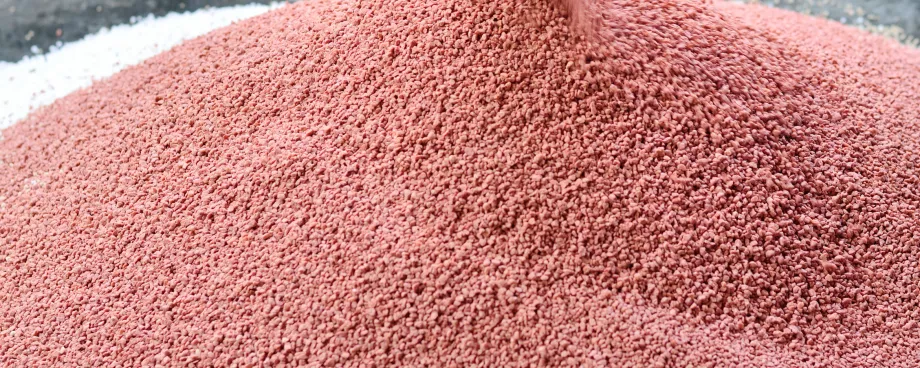| failure criterion | Specification of the mechanical conditions under which a bulk solid will fail to support the applied stress. |
| feeder | A device used to discharge a bulk storage container in a controlled manner. Typical equipment for this purpose are screw feeders, belt conveyors, scraper type conveyors, vibratory feeders, table feeders, rotary valves and disc type feeders. |
| FIBC | A Flexible Intermediate Bulk Container, See IBC. |
| filter porosity | The ratio (or percentage) of the void volume within the filter material to the total volume of the filter material. |
| flocc, floc; flocculate | An assemblage of particles which, having been initially dispersed, have become loosely coherent. |
| fluid | A liquid or gas. |
| fractions | Portions of the mass that fall into a certain defined category, usually a particle size range. |
| fume | Cloud of airborne particles, generally visible, that arise from condensing vapours from either a chemical or physical reactions. |
| Gausian distribution | (See normal distribution) |
| health hazard ranking | For substances within EU classification as a dangerous substance are ranked in five groups of acute health hazard with respect to corrosive/irritation and organ toxicity. These classes are ranked 1 – 5 ( with 0 for unidentified products). - Class 0: No data available relevant to human heath hazard - Class 1: Very high risk. (e.g. very acute toxicity). - Class 2: High risk. (e.g. acute toxicity). - Class 3: Moderate risk, (e.g. mild toxicity). - Class 4: Low risk, (e.g. low toxicity). - Class 5: No reasonable concern with regard to health hazard effects Five sub-chronic/chronic health hazards relating to allergy, neurotoxicity, carcinogenicicity, genotoxicity and rproductive toxicity are, ranked A – E, as below: - Class 0: No relevant data available - Class A: Severe effects from low exposure - Class B: Severe effects after medium exposure, or mild effects with low exposure - Class C: Severe effect only from extensive exposure, or to limited cases - Class D: Effects limited or applies to isolated cases. - Class E: No reason for concern with regard to heath effects. |
| HEPA filter | Acronym for High Efficiency Particulate Air filter, for particles in air, having a specified minimum collection efficiency to the D O P test. |
| heterogeneous material | Material in which a spot sample will have a significantly different value of the characteristics under consideration from the mean value of that characteristic of the bulk material. |
| homogeneous material | Material in which a spot sample will have the same value of the characteristic under consideration as the mean value of that characteristics for the bulk material. |
| homogeneous suspension | A suspension in which the particles are uniformly distributed in a liquid. |
| homogenisation | 1. (Relating to a fluid based product). Mixing using a high shear rate. 2. (Relating to a particulate solid). Re-ordering the particle distribution of a heterogeneous material to the condition of a homogeneous material. |
| hopper | 1. Generic term for a bulk storage container. 2. The converging section of a bulk storage container. (The ambiguity of this term demands that, for appropriate clarity, the meaning is clarified within the context in which it is used). |
| hopper half angle | The inclination of the wall of a symmetrical hopper from the vertical axis. |
| hopper section | (of bulk storage container) The converging section of a bulk storage container leading to the outlet. See hopper. |
| Hvorslev surface | The envelope of a family of yield loci on a three dimensional axis of shear stress, normal stress and bulk density. The boundary conditions are: - The line of tensile strength on the axis of density. - The critical state line, being the limiting shear strength of a bulk mass against its density. - The envelope of the yield loci at each condition of bulk density. - The bulk density condition at zero shear strength. (Maximum density for fluidity). - The bulk density condition of maximum consolidation. |
| hygroscopic | Possessing the tendency to absorb moisture from the atmosphere. In the case of particulate solids this leads to many potential flow problems as the effect of moisture changes the bulk strength and slip characteristics of the bulk, sometimes dramatically with only a small change of water content. Equilibrium atmospheric moisture conditions depend upon the ambient temperature, pressure and relative humidity. Changes in ambient conditions can cause moisture content variations according to the boundary surface contact conditions of the bulk mass. Moisture migration and condensation conditions can give rise to massive imbalances in moisture distribution, leading to caking or surface adhesion problems. (See moisture content). |
Glossary of Terms in Powder & Bulk Technology
1.3 General Terms
Page 3 of 7





